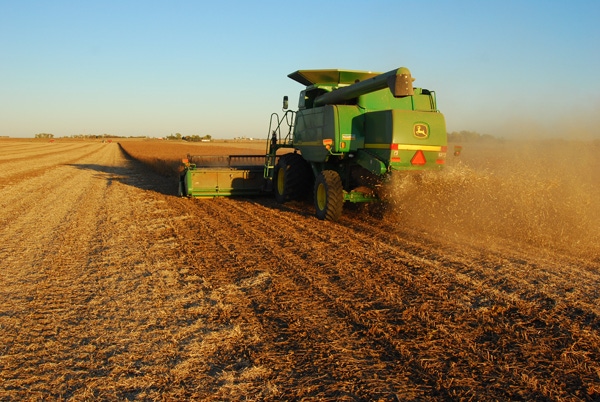October 13, 2011

Warm, dry fall weather can result in soybeans being harvested well below the market moisture content of 13 percent, according to Ken Hellevang, the North Dakota State University Extension Service's grain drying expert. In Eddy County, for example, harvested soybeans have been in the 8-9% range.
"On a 40-bu. crop, that equates to around 2 bu. of lost weight due to the beans being so dry," says Eddy County Extension agent Tim Becker. "At $11-12/bu., that’s around $20-25/acre in lost moisture."
While adding water to soybeans to increase their moisture content is illegal, producers can boost the moisture content by aerating the beans with humid air, provided they have enough time and a high enough airflow per bushel, Hellevang says.
If a bin of soybeans is aerated continuously, the beans would lose moisture during periods of low humidity and gain moisture when the humidity is high. Therefore, producers would need to make sure to operate aeration fans during weather with an average relative humidity of about 70% if they want to recondition soybeans to 13% during normal fall temperatures of 30-60° F.
The moisture doesn't change throughout the bin during reconditioning, Hellevang notes. Instead, a rewetting zone develops and moves slowly through the bin in the direction of the airflow.
In most cases, fall weather doesn't provide enough hours of high humidity to move the rewetting zone through the bin. If the fan is operated during high humidity, the soybeans in parts of the bin would be too wet to be stored safely.
"Mixing the wet layers with the dry layers would be best to reduce spoilage risk and avoid drying charges for the wet layers when the beans are sold," Hellevang says.
Bin dryers equipped with stirring augers work well for reconditioning soybeans. Emptying the bin and moving the beans through a grain-handling system will provide only limited mixing.
In beans with moisture contents of 10% or less, controlling the aeration fan so it runs only when the relative humidity of the air reaching the beans is greater than about 55% should result in rewetting. One way to accomplish that is to use a humidistat to turn the fan on any time the humidity is above 55%. Another option is to run the fan only at night because that's when humidity almost always is higher.
Optimal reconditioning options
Producers who aren't equipped to mix the soybeans after reconditioning need to avoid wetting the beans to moisture levels at which they are unsafe to be stored. Here are some ways to prevent excessive rewetting:
Add a second humidistat that stops the fan when the relative humidity reaches very high levels.
Install a microprocessor-based controller that monitors temperature and humidity, and runs only when air conditions will bring the crop to the desired moisture content.
The disadvantage of these options is that the fan doesn't run as many hours.
Reconditioning time primarily depends on the airflow per bushel and weather conditions. Reconditioning occurs the fastest when the airflow is high and the air is warm and humid. It will be the most successful in a drying bin that has a fully perforated floor and a fan that can deliver at least 0.75 cubic ft./minute of airflow/bushel.
Even with this airflow, moving a rewetting front all the way through the bin probably would take at least a month of fan operation.
Producers also need to be aware that soybeans swell when they absorb moisture, which could create enough pressure to damage bin walls, Hellevang says. One way to reduce that pressure is to use a vertical-stirring auger to mix layers of wet and dry beans. Another option is to unload some beans from the bin periodically.
Here are some other problems with low-moisture beans: more beans split; more damage occurs during harvest and handling, which results in reduced germination; and field loss will be greater.
To minimize damage during handling, use belt conveyors instead of augers or operate augers at slow speeds and keep them full. If using pneumatic conveyors, maintain proper air-to-grain ratios, make sure the conveying tubes have gentle curves and use a low conveying velocity. Also, minimize drop heights. Use bean ladders in situations in which beans may fall during conveying.
For more information about reconditioning, drying, handling and storing soybeans, visit the NDSU Extension Service's soybean production guide (pdf).
You May Also Like




